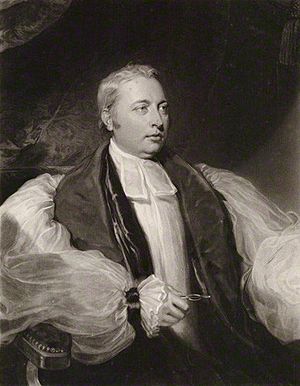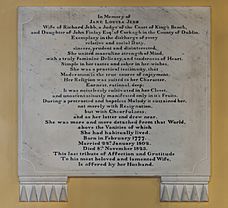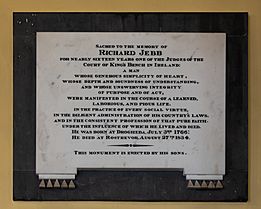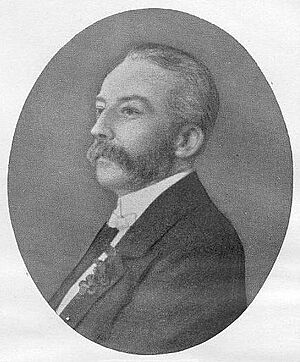Richard Jebb (barrister) facts for kids
Richard Jebb (1766–1834) was an important judge in Ireland during the 1800s. He came from a very talented family. Many of his relatives were famous, including a doctor, several religious leaders, and a well-known scholar.
Contents
Early Life and Family History
Richard Jebb was born in Drogheda, Ireland. He was the oldest son of John Jebb and his second wife, Alicia Forster. His father was an alderman in Drogheda, which meant he was a local government official. The family also owned land in Leixlip, County Kildare.
Richard's grandfather, also named Richard Jebb, moved to Ireland from Mansfield in England. His great-grandfather was a successful brewer, making beer.
Richard's Talented Relatives
Richard had a younger brother named John Jebb, who became a Bishop of Limerick. The brothers were very close. John lived with Richard when he was younger.
Even though their father lost a lot of money, Richard inherited a large fortune at age 21. This money came from his father's cousin, Sir Richard Jebb, 1st Baronet. This cousin was a famous doctor who even worked for King George III. Another cousin, John Jebb, was a religious reformer. He was the son of another relative, John Jebb, who was the Dean of Cashel.
Richard Jebb's Career as a Judge
Richard Jebb went to school in Drogheda and then studied at Trinity College Dublin. He finished his studies in 1786. He was friends with Theobald Wolfe Tone, a famous political leader. Richard even helped with Tone's book, "Belmont Castle."
However, Richard did not agree with Tone's strong political ideas. As he got older, Richard became more traditional in his views. Some people, like Daniel O'Connell, even called him a strong supporter of the Orange Order.
Becoming a Lawyer and Judge
In 1789, Richard became a lawyer in Ireland. He was promoted to King's Counsel in 1806. He was not completely against the Act of Union 1800, which joined Ireland and Great Britain. He even wrote a pamphlet that tried to be fair to both sides of the argument.
After the Act of Union, Richard accepted important jobs in the new government. He became a Third Serjeant in 1816 and a Second Serjeant in 1818. In the same year, 1818, he became a judge in the Court of King's Bench (Ireland).
Notable Trials
As a judge, one of his most well-known cases was the trial of John Scanlan in 1819. Scanlan was accused of causing the death of his lover, Ellen Scanlan. This case later became famous as the story of The Colleen Bawn.
Richard Jebb passed away suddenly in 1834 at his home in Rostrevor, County Down. He was a victim of the first major cholera outbreak in Europe during the 1800s.
Richard Jebb's Family Life
In 1802, Richard married Jane Louisa Finlay. She was the oldest daughter of John Finlay, a Member of Parliament for County Dublin. Jane Louisa was known for her strong character. She passed away in 1823 after a long illness.
Richard and Jane Louisa had six children: five sons and one daughter. Their most famous child was John Jebb (1805-1886), who became a Canon at Hereford Cathedral. Their second son, Robert, also became a lawyer like his father. Robert had a successful career.
Richard's Grandchildren
Robert Jebb married Emily Harriet Horsley. Their children included the politician and scholar Richard Claverhouse Jebb and the social reformer Eglantyne Louisa Jebb.
There are memorials for Richard and Jane Louisa Jebb in St. Peter's Church in Drogheda.
Richard Jebb's Character
People described Richard Jebb as a fair and kind judge, but also firm. One historian, Elrington Ball, said that Richard was a very talented person. Like his brother, Bishop Jebb, he was often underestimated because he was modest and humble.
Both brothers had a good sense of humor. However, the Bishop usually only told jokes to his family. Daniel O'Connell, who did not like Richard Jebb, called him a "frightful judge." But O'Connell often criticized most Irish judges of that time.





